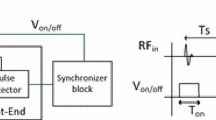Abstract
This paper reviews and discusses the design of a low-power single-full-band (3.1–10.6 GHz) noncarrier impulse-radio ultra wideband (UWB) transmitter featuring 5th-order Gaussian derivative pulse shaping, integrated BPSK modulation, and 2.5 kV whole-chip ESD (electrostatic discharge) protection. The UWB transmitter design has been implemented in a commercial 0.18 μm CMOS technology with a very small die size of 0.25 mm2. The fabricated chips have demonstrated full functionality, extremely low power consumption of 0.14 pJ/p-mV, and an ultra short pulse width of 394 ps. This ESD-protected UWB transmitter has the potential to support wireless streaming to gigabit per second (Gbps).
Similar content being viewed by others
References
1st Report & Order: Revision of Part 15 of the Commission’ Rules Regarding UWB Transmission Systems, FCC, 02-48, 2002
Wang X, Qin B, Xie H, et al. FCC-EIRP-aware UWB pulse generator design approach. In: IEEE Intl. Conf. Ultra Wideband, 2009. 592–596
Norimatsu T, Fujiwara R, Kokubo M, et al. A UWB-IR transmitter with digitally controlled pulse generator. IEEE J Solid-State Circ, 2007, 42: 1300–1309
He J, Zhang Y. A CMOS ultra-wideband impulse radio transceiver for interchip wireless communications. In: IEEE Intl. Conf. Ultra Wideband, 2007. 626–631
Saha P, Sasaki N, Kikkawa T. A single-chip Gaussian monocycle pulse transmitter using 0.18 μm CMOS technology for intra/interchip UWB communication. In: VLSI, 2006. 204–205
Martynenko D, Fischer G, Klymenko O. A high band impulse radio UWB tansmitter for communication and localization. In: IEEE Intl. Conf. Ultra Wideband, 2009. 359–363
Diao S, Zheng Y, Heng C. A CMOS ultra low-power and highly efficient UWB-IR transmitter for WPAN applications. IEEE Trans Circ Syst II, 2009, 56: 200–204
Lim G, Zheng Y, Yech W, et al. A novel low power UWB transmitter IC. In: IEEE Symp. RFIC, 2006
Qin B, Chen H, Wang X, et al. A single-chip 33 pJ/pulse 5th-derivative Gaussian based IR-UWB transmitter in 0.13 μm CMOS. In: IEEE Symp. Circuits and Systems, 2009. 401–404
Wentzloff D, Chandrakasan A. Gaussian pulse generators for subbanded ultra-wideband transmitters. In: IEEE Trans Microw Theory Tech, 2006, 54: 1647–1655
Lim K, El-Gamal M. Design of low power CMOS ultra-wideband 3.1–10.6 GHz pulse based transmitters. In: IEEE CICC, 2008. 583–586
Xu R, Jin Y, Nguyen C. Power-efficient switching-based CMOS UWB transmitters for UWB communications and radar systems. IEEE Trans Microw Theory Tech, 2006, 54: 3271–3277
Wang A. On-chip ESD protection for integrated circuits: an IC design perspective. Kluwer, 2002
Wang A, Feng H, Zhan R, et al. A review on RF ESD protection design. IEEE Trans Electr Dev, 2005, 52: 1304–1311
Guan X, Wang X, Lin L, et al. ESD-RFIC co-design methodology. In: IEEE RFIC, 2008. 467–470
Feng H, Chen G, Zhan R, et al. A mixed-mode ESD protection circuit simulation-design methodology. IEEE J Solid-State Circ, 2003, 38: 995–1006
Author information
Authors and Affiliations
Corresponding author
Rights and permissions
About this article
Cite this article
Wang, X., Lin, L., Tang, H. et al. Low power 3.1–10.6 GHz IR-UWB transmitter for Gbps wireless communications. Sci. China Inf. Sci. 54, 1094–1102 (2011). https://doi.org/10.1007/s11432-011-4222-y
Received:
Accepted:
Published:
Issue Date:
DOI: https://doi.org/10.1007/s11432-011-4222-y




